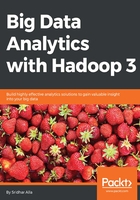
Simple deployment for HBase
If you are intent on a simple deploy profile for the Apache HBase cluster where the data
loading is light but the data needs to persist across node comings and goings, you could
consider the Standalone HBase over HDFS deploy mode.
http://mirror.cogentco.com/pub/apache/hbase/1.2.6/
The following screenshot is the download link to HBase 1.2.6:

Download hbase-1.2.6-bin.tar.gz to your local machine. Then extract the HBase
binaries:
tar -xvzf hbase-1.2.6-bin.tar.gz
The following is the content of the extracted HBase:

This is a useful variation on the standalone HBase setup and has all HBase daemons running inside one JVM but rather than persisting to the local filesystem, it persists to an HDFS instance. Writing to HDFS where data is replicated ensures that data is persisted across node comings and goings. To configure this standalone variant, edit your hbasesite.xml setting the hbase.rootdir to point at a directory in your HDFS instance but then set hbase.cluster.distributed to false.
The following is the hbase-site.xml with the hdfs port 9000 for the local cluster we have installed mentioned as a property. If you leave this out there wont be a HBase cluster installed.
<configuration>
<property>
<name>hbase.rootdir</name>
<value>hdfs://localhost:9000/hbase</value>
</property>
<property>
<name>hbase.cluster.distributed</name>
<value>false</value>
</property>
</configuration>
Next step is to start HBase. We will do this by using start-hbase.sh script:
./bin/start-hbase.sh
The following screenshot shows the HBase cluster we just installed:

The following screenshot shows are more attributes of the HBase cluster setup showing versions, of various components:

Figure: Screenshot of attributes of the HBase cluster setup and the versions of different components
Once you have an Apache HBase cluster ready to use, perform the steps in the following section.